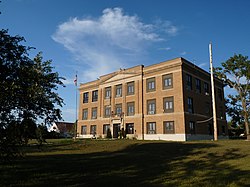Ziebach County, South Dakota | |
|---|---|
 Ziebach County Courthouse | |
 Location within the U.S. state of South Dakota | |
 South Dakota's location within the U.S. | |
| Coordinates: 44°59′N101°40′W / 44.98°N 101.67°W | |
| Country | |
| State | |
| Founded | 1911 |
| Named after | Frank M. Ziebach |
| Seat | Dupree |
| Largest city | Dupree |
| Area | |
• Total | 1,971 sq mi (5,100 km2) |
| • Land | 1,961 sq mi (5,080 km2) |
| • Water | 9.3 sq mi (24 km2) 0.5% |
| Population (2020) | |
• Total | 2,413 |
• Estimate (2024) | 2,418 |
| • Density | 1.230/sq mi (0.4751/km2) |
| Time zone | UTC−7 (Mountain) |
| • Summer (DST) | UTC−6 (MDT) |
| Congressional district | At-large |
Ziebach County (Zee-bahk) is a county in the U.S. state of South Dakota. As of the 2020 census, the population was 2,413. [1] Its county seat is Dupree. [2] It is the last county (or county equivalent) in the United States alphabetically.
Contents
- History
- Geography
- Buttes
- Major highways
- Adjacent counties
- Protected areas
- Lakes and reservoirs[5]
- Demographics
- 2020 census
- 2010 census
- Communities
- Cities
- Census-designated places
- Unincorporated communities[5]
- Unorganized territories
- Politics
- Education
- See also
- References
Ziebach County consists entirely of Indian reservations. Most of the county is within the Cheyenne River Indian Reservation and the remainder is within the Standing Rock Sioux Reservation.
